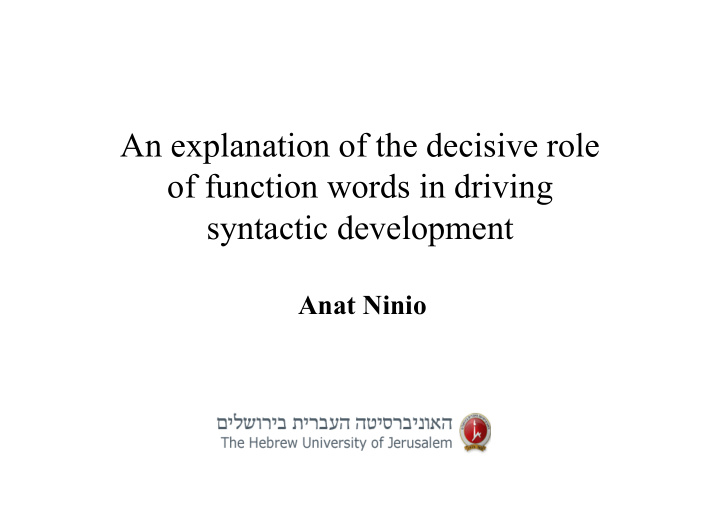



An explanation of the decisive role of function words in driving syntactic development Anat Ninio
English vocabulary consists of two kinds of words: Content words (CWs) and function words (FWs). CWs are verbs, nouns, adjectives and adverbs. For example eat, hand, pretty, fast . FWs are determiners, prepositions, auxiliaries, pronouns, coordinators and subordinators. For example this, of, will, she, and, if.
We ask: Why are content words lesser predictors of syntactic development? We wanted to understand the advantage of the early mastery of FWs over CWs for syntactic development (e.g., Le Normand et al., 2013). We tested the hypothesis that the learning of FWs necessarily involves learning their syntax, but not the learning of CWs (despite the popular “syntactic bootstrapping” theory).
The proposed explanation: FWs such as determiners are defined by their syntax, therefore learning them requires cracking the code of syntax in multiword expressions. By contrast, learning CWs merely requires that the words are matched to their meaning in the non-linguistic context, but may not necessarily need an understanding of their syntactic behaviour (Ninio, 2016).
Hypothesis: Contrasting two-word sentences as the minimal multiword types with single-word utterances that lack syntax: We hypothesize that FWs will be learned from at least two-word long input sentences, with their syntax, whereas CWs will be equally learned from single- word utterances without mastering their syntax.
Method: Samples English-language parental and child samples were taken from the CHILDES archive, N=350 .
Parental corpus Parents produced 22,595 single-word utterances and 23,143 2-word long sentences. Interjections were excluded from the corpus and also interrupted utterances.
Child corpus The children were at the beginning of multiword combinations, mean age 2;0.18 (SD =0;4.8). They produced 24,444 single-word utterances and 11,642 two-word long syntactically structured sentences. Only spontaneous utterances were included in the study.
All words in the corpus were tagged for part of speech (POS) category: POS examples: noun ball, bear, baby verb jump, hear, tickle adjective big, good, red adverb again, quickly, here pronoun I, me, you determiner the, that, mine preposition on, in, to conjunction and, but, or auxiliary verb (incl. copula) can, do, is
Two-word sentences were analyzed for syntactic structure, their head-words taken as targets of analysis . I write. (head is a verb) Large bag. (head is a noun) That box. (head is a determiner) Too cold. (head is an adjective) For you. (head is a preposition) I can. (head is an auxiliary verb)
Hypothesis testing on the input The hypothesis was first tested by comparing the production of CWs and FWs in parents’ single word speech and as heads of their two-word long sentences. We predicted that FWs occur mostly as heads of 2-word long sentences, but CWs also as 1-word utterances.
Parents’ Use of Words by Form- Class and Length of Sentence 100% 90% 80% 70% Percent of tokens 2 words 60% 50% 1 word 40% 30% 20% 10% 0% Form classes
Results: In four categories of function words, namely subordinator, determiner, preposition and auxiliary verb, there were almost no single- word utterances produced by parents. The hypothesis of requiring a syntactic combination for minimal expression was supported for function words serving as heads of combinations, not for pronouns and particles that only serve as dependents. As expected, the four content classes occurred in a mixture of single-word and multiword sentences.
Hypothesis testing on child speech Next, we repeated the analysis on children’s single-word and two-word long speech. The results were very similar to those of parental speech.
Child Use of Words by Form- Class and Length of Sentence 100% 2 words 1 word 90% 80% 70% Percent of tokens 60% 50% 40% 30% 20% 10% 0% particle pronoun adverb noun adjective verb auxiliary prepositi determin subordin verb ator on er Form classes
Children‘s FWs are learned from parents’ multiword input We computed a Pearson correlation coefficient between the proportion of single-word tokens in children’s and parents’ speech in various form-classes, and found that the correlation is very high: 0.99 . We may conclude that children learn FWs only from multiword parental sentences, hence learning them involves cracking their syntax . This may explain the better predictive power of FWs for syntactic development.
References Le Normand, M-T, Moreno-Torres, I, Parisse, C. and Dellatolas, G. (2013). How do children acquire early grammar and build multiword utterances? Child Development , 842 , 647-661. Ninio, A. (2016). Learning transitive verbs from single-word verbs in the input by young children acquiring English. Journal of Child Language , 43 , 1103-1130.
Additional references Anat Ninio. 2019. Complement or adjunct? The syntactic principle English- speaking children learn when producing determiner-noun combinations in their early speech. First Language, 391:33-44. Ninio, A. (2019). Learning to structure sentences through the acquisition of grammatical words: Introduction to the special issue on the role of grammatical words in young children’s syntactic development. In A. Ninio (guest editor), The role of grammatical words in young children’s syntactic development: Special issue. First Language, 39(1), 3-8 . http://micro5.mscc.huji.ac.il/~msninio/
Thank you !
Recommend
More recommend